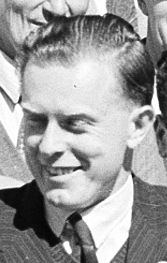Bernard Mills facts for kids
Quick facts for kids
Bernard Mills
|
|
|---|---|

Mills at the International Union of Radio Science conference, Sydney 1952
|
|
| Born |
Bernard Yarnton Mills
8 August 1920 |
| Died | 25 April 2011 (aged 90) |
| Awards | Fellow of the Royal Society |
Bernard Yarnton Mills (born August 8, 1920 – died April 25, 2011) was a brilliant Australian engineer. He was a true pioneer in the field of radio astronomy in Australia. This means he was one of the first people to use radio waves to study objects in space, like stars and galaxies. He is famous for designing and building two very important radio telescopes: the Mills Cross Telescope and the Molonglo Cross Telescope.
A Young Engineer's Journey
Bernard Mills was born in Manly, Australia, on August 8, 1920. His dad, Ellice Mills, was an architect from England. His mom, Sylphide Dinwiddie, was a dance teacher from New Zealand.
Bernard was a very smart student. At just 16 years old, he won a scholarship to study engineering at the University of Sydney. He finished his degree in 1942. Later, in 1950, he earned a Master of Engineering degree.
In 1942, he married Lerida Karmalsky. Lerida was also very talented; she won the Australian Chess championship in 1940 when she was only 18! Bernard and Lerida had three children together. Sadly, Lerida passed away in 1969. The next year, Bernard married Crys, who had two children close in age to his own.
Building Giant Ears for Space
In 1948, Bernard started working with a new group at the CSIRO. CSIRO is a big Australian science organization. This group was focused on radio astronomy.
It was here that Bernard had a brilliant idea for a new type of radio telescope. This design became known as the Mills Cross radio telescope. The very first one started working in 1954. These telescopes look like a giant "X" on the ground. They use two long lines of antennas to listen to radio waves from space.
In 1959, Bernard earned his Doctor of Science degree in engineering. A year later, in 1960, he became a physics professor at the University of Sydney. He continued to develop his ideas for even bigger telescopes, which he called the "Super Cross."
By 1965, he was appointed a full professor of physics, specializing in astrophysics (the study of how stars and galaxies work). His most famous creation, the Molonglo Cross Telescope, began operating in 1967. This telescope was even larger and more powerful than the first Mills Cross.
Bernard retired from the university in 1985, leaving behind an amazing legacy in radio astronomy.
Awards and Special Recognition
Bernard Mills received many important awards and honors for his groundbreaking work:
- 1957: He was awarded the Thomas Ranken Lyle Medal.
- 1959: He became a Fellow of the Australian Academy of Science (FAA). This means he was recognized as one of Australia's top scientists.
- 1963: He became a Fellow of the Royal Society (FRS). This is a very high honor for scientists in the United Kingdom and Commonwealth countries.
- 1967: He shared the Britannica Australia Award for Science.
- 1976: He was appointed a Companion of the Order of Australia (AC). This is one of Australia's highest civilian honors.
- 2006: He received the Grote Reber Gold Medal for Radio Astronomy. This award recognizes outstanding achievements in radio astronomy.

